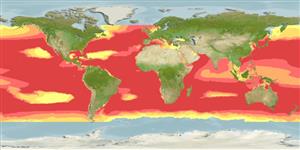Common names from other countries
>
Stomiiformes (Lightfishes and dragonfishes) >
Sternoptychidae (Marine hatchetfishes) > Sternoptychinae
Etymology: Argyropelecus: Greek, argyros = silvered, silver + Greek, pelekys = axe (Ref. 45335).
Environment: milieu / climate zone / depth range / distribution range
Ökologie
seewasser bathypelagisch; tiefenbereich 0 - 2400 m (Ref. 74511), usually 100 - 700 m (Ref. 28981). Deep-water; 60°N - 56°S
Eastern Atlantic: north of British Isles to South Africa, including western Mediterranean. Western Atlantic: New Jersey, USA to Argentina (Ref. 26340). Northwest Atlantic: Canada (Ref. 5951). Eastern Pacific: throughout the California Current area, seaward of the continental shelf (Ref. 35838). Known from tropical and subtropical waters of all oceans (Ref. 47377). South China Sea (Ref.74511).
Length at first maturity / Size / Gewicht / Alter
Maturity: Lm ?, range 3 - ? cm
Max length : 5.1 cm TL Männchen/unbestimmt; (Ref. 96016); max. veröff. Gewicht: 1.42 g (Ref. 128245); max. veröff. Alter: 1.00 Jahre (Ref. 5168)
Rückenflossenstacheln (insgesamt) : 0; Rückenflossenweichstrahlen (insgesamt) : 8 - 9; Afterflossenstacheln: 0; Afterflossenweichstrahlen: 11 - 12; Wirbelzahl: 36 - 39. Body bright silvery in color; body and trunk with dusky coloration at night (Ref. 4054). Branchiostegal rays: 10 (Ref. 35838).
Oceanic (Ref. 4739) and mesopelagic, mainly at 250-650 m (Ref. 4054). Depth range from 100-700 m (Ref. 4462) and from 460-1082 m in the eastern Ionian Sea (Ref. 56504). Adults make marked vertical migrations (Ref. 4739). Found singly or in small groups (Ref. 4739). An opportunistic feeder at dusk on calanoid copepods, small fishes, etc (Ref. 4739). Sexual dimorphism with regard to body size (Ref. 5168), the males being slightly smaller than the females (Ref. 8966). Oviparous, with planktonic eggs and larvae (Ref. 35838).
Occurs between 200 and 700 m depth during the day, concentrated between 350 and 550 m, and between 100 and 650 m at night, preferring a depth between 150 and 380 m Ref. 47377). Also Ref. 58302.
Spawns more than once per season with egg batches about 50-500 egg/ovary pair, the number increasing with increased animal size (Ref. 4739).
Gon, O., 1990. Sternoptychidae. p. 123-126. In O. Gon and P.C. Heemstra (eds.) Fishes of the Southern Ocean. J.L.B. Smith Institute of Ichthyology, Grahamstown, South Africa. (Ref. 5168)
IUCN Rote Liste Status (Ref. 130435)
CITES (Ref. 128078)
Not Evaluated
Bedrohung für Menschen
Harmless
Nutzung durch Menschen
Fischereien: nicht kommerziell
Tools
Zusatzinformationen
Download XML
Internet Quellen
Estimates based on models
Preferred temperature (Ref.
115969): 5.5 - 21.3, mean 11.3 (based on 2694 cells).
Phylogenetic diversity index (Ref.
82804): PD
50 = 0.5078 [Uniqueness, from 0.5 = low to 2.0 = high].
Bayesian length-weight: a=0.01698 (0.00984 - 0.02932), b=3.11 (2.96 - 3.26), in cm Total Length, based on LWR estimates for this species & Genus-body shape (Ref.
93245).
Trophic level (Ref.
69278): 3.1 ±0.14 se; based on food items.
Widerstandsfähigkeit (Ref.
120179): hoch, Verdopplung der Population dauert weniger als 15 Monate. (tm=1; tmax=1).
Fishing Vulnerability (Ref.
59153): Low vulnerability (10 of 100).
